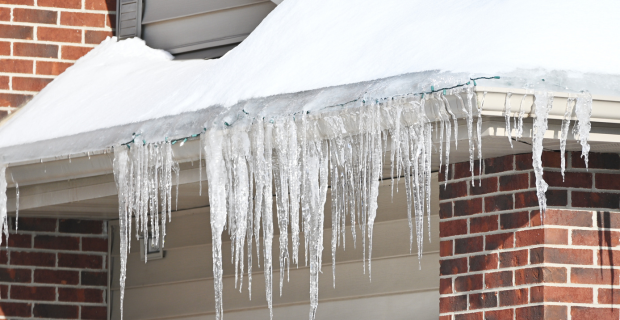Date Published: 2025/01/13
Read Time: mins
Common flood risks during the winter and how to prevent them

When we think about flooding, we mostly think about spring floods and summer storms, making us believe flooding only happens during half the year. That is not entirely true. The risk of flood does not dry up in the winter, and solid water is not the only thing to worry about when it is cold. Throughout Ontario, the threat of flooding persists through the cold months. Here is what you need to know about the most common flood risks during the winter and what you can do to avoid them.
1. Burst pipes
One of winter’s most common insurance claims is burst pipes. While frozen pipes do not always burst, their risk increases significantly without some attention and maintenance. A frozen pipe will likely burst when the water freezes, expands, and builds pressure1. If the temperature stays below freezing, the water will continue to expand until the pipe ruptures at its weakest point1. If it is not repaired quickly, mold will grow, producing more damage and other challenges.
Fortunately, there is home insurance coverage for water damage caused by frozen pipes, but some exclusions exist. According to the plumbing pros at Mr. Rooter Plumbing, there are steps you can take to prevent pipes in your home from freezing:
- Before winter arrives, drain any exterior water lines.
- Keep your cabinet doors open to warm your pipes, especially if they run along an exterior wall.
- Turn up the heat in your home to help warm your plumbing system.
- When the temperature is below freezing, allow your faucets to drip, so the water continues to move. If you notice your slow drip has stopped and you suspect a pipe is frozen, turn off the main water line, turn on the faucet to relieve any pressure, and/or use a heat source (e.g., blow dryer, heat lamp, or space heater) to warm the pipe gradually and safely.
- Although not guaranteed, insulating your pipes will help them be better equipped to withstand extended periods of cold weather.
- Be proactive in scheduling regular plumbing inspections to identify and repair any issues early.
2. Snowmelt
Snowmelt is an integral part of the water cycle. However, when the snow thaws too quickly for the soil to absorb, surrounding bodies of water and drainage systems can flood. Usually, snowmelt floods occur in small, localized events, but that does not mean these events do not result in significant damage. The typical snow-to-water ratio is 10:12. Meaning when it snows 25 centimetres, that is roughly equal to 2.5 centimetres of water. Just 2.5 centimetres of floodwater can cost you thousands of dollars in repairs.
Because of climate change, Canada is warming twice as fast as the rest of the globe3, causing more unseasonably warm temperatures every winter. The 2019 Ontario floods are an excellent example of this trend. Scientists observed a colder-than-average winter with accelerated snowmelt, which was exacerbated by numerous rainfalls4. This resulted in flooding from high water levels, especially around large bodies of water like the Great Lakes4. It is predicted that bigger severe snowstorms will likely become more common over the decades5.
3. Ice jams
Ice jams are a natural part of winter river processes. They form when ice blocks the flow of water, causing water levels to rise and lead to flooding. Ice jams can occur anytime and anywhere during the winter. There are two common types of ice jams, freeze-up and breakup. Freeze-up ice jams occur when a weak ice cover forms, collapses, then thickens, partially blocking the flow of water. Breakup ice jams occur when snowmelt runoff raises the water levels, lifts and breaks the ice cover, then the broken ice flows downstream and jams against a solid ice cover.
Ice jam flooding is more difficult to predict than open-water floods because it depends on more factors like the amount of snow, the amount of flowing water and ice, the thickness or strength of the ice, the shape of the body of water, and the overall temperature. Similar to snowmelt, ice jam flooding occurs in small, localized events, but it can happen quickly, within minutes or hours. In addition to the effects of floodwater, the force of the ice can damage structures and erode riverbanks, not to mention that the floodwater can freeze in place if the weather is frigid.
4. Winter storms
The risk of flooding has increased across Canada throughout the winter months, especially in areas with more accumulated snow. Fluctuating temperatures have allowed for heavy downpours causing flash floods and water pooling on roads from excessive runoff. These winter storms and subsequent floods are common in areas near Lake Huron, Georgian Bay, and the eastern region of Ontario. Still, they can also happen in Southwestern Ontario or the Greater Toronto Area.
Steps you can take to keep your property safe
The best way to defend your property from flooding is to ensure you have safeguards in place before anything happens. As an Orbit customer you might be eligible for great add-ons like the Sewer Back-Up/Water Endorsement and the Overland Water Protection if you meet the criteria to purchase for protection if water enters your property. Other precautions you can take include:
- Maintaining your roof and, if possible, removing any snow or ice on top.
- Clearing snow at least a foot away from your home.
- Ensuring your gutters and downspouts are free of debris and directed away from your home.
- Investing in a sump pump and inspecting it regularly.
It’s important to prepare your property as soon as you can to weather any storm. If you have questions about your Orbit home insurance coverage, visit our office locations page to contact an Orbit insurance broker today. If you’re shopping for home insurance, you can request a quote here and one of our knowledgeable insurance brokers will contact you.
2. AccuWeather
3. CTV News
5. CBC News